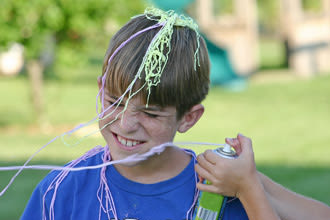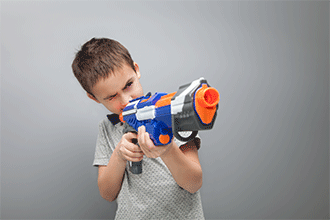Avoid these toys in 2024 to prevent kids’ eye injuries

What child doesn’t like toys? And what parent or grandparent doesn’t enjoy buying a fun new toy for their young loved ones, particularly around the holidays?
But some toys that look really fun can pose a serious risk of eye injury — including serious injuries that can result in permanent vision loss.
Toys cause thousands of eye injuries every year
According to the U.S. Consumer Product Safety Commission, nearly 150,000 children were seen in U.S. emergency departments in 2020 due to toy-related injuries.
Nearly half of these were “head and face” injuries, which include trauma to the eyes and area around the eyes. The same injuries represented more than 65% of total injuries to children under age 4.

Aerosol string that hits the eye can cause a painful irritation of the eye called chemical pink eye.
Despite this, it can be easy to forget about eye safety when you’re shopping for toys.
Online surveys conducted by All About Vision revealed that
When choosing toys for their kids, 41% of parents said they “rarely” or “never” consider eye safety.
When asked whether any of their children’s toys could cause an eye injury, 54% of parents responded “definitely” and 22% said “possibly.”
What kind of eye injuries can a toy cause?
Common eye injuries caused by mishaps with toys can range from a minor scratch to the front surface of the eye (called a corneal abrasion) to very serious, sight-threatening injuries.
Severe eye injuries can include the following:
Traumatic cataracts
Bleeding inside the eye
While some of these injuries can be treated, others can cause lifelong damage.
The “worst” toys of 2023-2024
World Against Toys Causing Harm (W.A.T.C.H.) is a nonprofit organization founded to protect children from toys that could cause physical harm. At the beginning of the holiday season each year, the group publishes a Top 10 list of the year’s “worst” toys, in terms of safety.
The lists can help parents make informed buying decisions during the 2023 holiday season and well into 2024. The next list of nominees will be released sometime before Thanksgiving 2023.
The 2023 nominees include three toys that could cause eye injuries in children:
Disney Raya’s Action & Adventure Sword
Disney’s 2021 film Raya and the Last Dragon tells the story of Raya, a warrior whose town, Kumandra, is suddenly threatened. Raya begins a quest to save the land — but to do so, she must find and befriend the last dragon in Kumandra.
Such an adventure requires special equipment. In Raya’s case, it’s a sword. A toy version of this sword is now available for children through select retailers.
But the pointed end of the sword poses a serious risk for eye injuries. The base of the sword also appears fairly pointed on two different sides. Despite this, the suggested age for the toy is only 3 years and older.
The manufacturer includes a choking hazard for the sword, but it’s highly recommended that children have strong supervision for other potential dangers during playtime, including risk of eye injury.
Black Panther Wakanda Battle Claws
In addition to Raya and the Last Dragon, Black Panther has been an impressive hit among adventure stories.
The Black Panther Wakanda battle claws allow kids to roleplay as Black Panther himself. They can embrace their imagination and spring into action against harm and evil as the feline-superhero. The dress-up gloves even have light and sound features for the full effect.
The claws are appealing for any Black Panther fan, but if used recklessly, they can be very dangerous. Being that they are claws, there are 10 different sharp points to watch out for (one on each finger).
It should be noted that the left hand of the pair also has an extend-and-retract feature. And even if the child is extra careful with the gloves, there’s a chance they can accidentally press the extend button. If a playmate is standing too close to the claws at that time, they can be seriously injured — especially in the eyes or face.
Are the battle claws more suitable for older kids? It’s possible, but the gloves only measure about 12 inches by 5 inches, meaning they were designed for small hands. The manufacturer recommends the claws for children 5 and older. Use at your discretion.
Nerf Pro Gelfire Mythic Blasters
Hasbro’s Nerf guns are notorious for eye injury risks. The Nerf Pro Gelfire Mythic Blaster is no exception.
The product is packed with round, dehydrated polymer beads (gelfire rounds) used as “ammunition.” The user is instructed to place the rounds in water to hydrate them before shooting. Rounds fly at a high-velocity and then burst when they hit a target. Up to 10 beads can be fired at a time under semi-automatic or full-automatic modes.
The toy includes some protective eyewear, which is crucial for anyone near the toy when it is in use. The manufacturer also warns users not to eat gelfire rounds and to keep the rounds away from pets. They also disclose the risk of eye injury, as well as fire and burn risks. Hasbro recommends the gun for teens ages 14 and up.
You can see the complete list of “worst toy” nominees on toysafety.org.
Other toys that pose a high risk of eye injury
Also consider this list of six types of toys you might want to cross off your list when buying gifts for young children. Each poses a high potential risk for eye injuries — especially if used by young children without adult supervision and guidance:

Guns that shoot ANY type of projectile. This includes toy guns that shoot lightweight, cushy darts. You might think these soft projectiles would pose little or no risk, but toy guns of this type can shoot up to distances of 75 feet. The darts move at speeds fast enough to cause a serious eye injury – especially when used at close range indoors.
Water balloon launchers and water guns. Water balloons can cause serious blunt trauma to the eye that can cause retinal detachment and lead to permanent vision loss. Even toy guns that shoot a stream of water can cause serious eye damage, especially when used at close range.
Games that include toy fishing poles. The end of a toy fishing pole or objects secured to the end of the fishing line can easily end up in a playmate’s eye.
Toy wands, swords, sabers or guns with bayonets. There’s really no need to explain why these are a bad idea, right?
Aerosol string. The chemicals in these products can cause eye irritation and a type of pink eye called chemical conjunctivitis. When used at close range, aerosol string can also cause a corneal abrasion that could lead to a serious eye infection.
Laser pointers and bright flashlights. Though technically not toys, many children love to play “laser tag” or “flashlight tag.” Portable laser pointers, like those used for business presentations, should never be used by children. The light intensity of these devices is enough to cause permanent vision loss. Even high-powered LED flashlights can be dangerous, because they can cause temporary blindness. This puts children at risk of a fall or other accident.
How to choose eye-friendly toys
If you are buying toys for grandchildren or the children of other relatives or friends, ask for suggestions from the child’s parents. Discuss any toys you’re thinking about purchasing to make sure the child’s parents are okay with the type of toy you’re considering.
It’s usually best to shop for children’s toys in a store rather than online. This helps you see the toy’s features up close to help you decide if it’s safe enough for a young child.
Toy packaging usually includes a recommended age range of children for whom the toy was designed. But keep in mind that these are general guidelines only. A toy that may be appropriate for one child may not be safe for another child of the same age. (It depends on their level of maturity and personality.)
Finally, when buying toys for older children, keep in mind that they may have younger siblings who could have access to the toys. It’s possible a new toy may not end up in the hands of the child you bought it for.
READ NEXT: More information about toys and eye safety
Toy-related deaths and injuries, calendar year 2020. U.S. Consumer Product Safety Commission. July 2021.
2022 "10 worst toy" list. World Against Toys Causing Harm. November 2022.
Page published on Wednesday, February 27, 2019
Page updated on Monday, November 27, 2023






